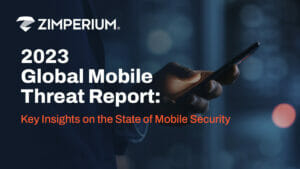
Clone phishing is a phishing attack that involves replicating a legitimate mobile app or website to trick users into providing sensitive data or login credentials. Clone phishing, more commonly associated with email and websites, can also be used on mobile apps. Here’s an example of how it can be used within mobile apps.
- App Cloning: Attackers can create an official mobile app’s fake or malicious version. Cloned apps often closely resemble the original app in appearance and functionality, making it hard for users to tell the difference.
- Distribution: Attackers can distribute cloned apps through various means, including malicious websites, third-party app stores, or even social engineering tactics. Users may install the cloned application, believing it is the real thing.
- Phishing Techniques: Once the users open the cloned application, they may see phishing techniques designed to trick them. This could include fake login pages asking for sensitive information like usernames, passwords, or credit card details.
- Data Theft: As soon as users enter their credentials or personal data, attackers steal and capture this information. The attackers then use this stolen information to commit various crimes, including identity theft, financial fraud, or selling it on the dark web.
- Malware Delivery: The cloned application could be used to deliver malware on the user’s device, in addition to phishing. Malware can steal information, spy on users, or engage in malicious activities.
Consider the following precautions to protect yourself against clone phishing in mobile apps:
- Stick to Official App Stores: Download mobile apps from only official app stores, such as the Apple App Store for iOS or Google Play Store for Android. These platforms have security features to reduce the risk of malicious applications.
- Check App Permissions: Review the permissions that an app requests before installing it. Be careful if an application requests excessive or unnecessary access.
- Verify App Developer: Check the developer information and read reviews before downloading. Legitimate apps usually have a reputable app developer behind them.
- Update your apps: Keep up-to-date with the latest mobile apps and operating system versions. These updates often contain security patches that protect against known vulnerabilities.
- Strong Authentication: Use two-factor authentication (2FA) or multi-factor verification (MFA) whenever possible to add a layer of security to accounts.
- Stay informed: Be aware of common phishing techniques and be suspicious of requests for sensitive information from apps.
Types of Clone Phishing
There are several types of cloned phishing attacks.
- Email Clone Phishing: In email clone phishing, attackers create fake emails that look like they are from a reputable source, such as a well-known company, financial institution, or government agency. These emails may contain malicious links or files that can lead you to phishing sites or malware.
- Website Clone Phishing: In website clone fraud, attackers copy legitimate websites, often with similar design and content, to trick users into providing sensitive information. These fake websites might ask for login credentials, financial data, or personal information. These sites can be accessed by phishing emails or links.
- App Clone Phishing: App clone fraud involves creating fake or malicious mobile apps that closely resemble the appearance and functionality of legitimate apps. Users can be tricked into downloading and installing these malicious apps. This can lead to the theft or installation of malware.
- Social Media Clone-Phishing: Attackers create phony social media pages or profiles that appear to be from a trusted person or organization. They use these fake accounts to engage users and obtain personal information such as login credentials or to spread malware.
- Text/SMS Clone Phishing: In text or SMS clone phishing, attackers send text messages that appear to be from legitimate sources such as banks, government agencies, or popular websites. These texts may contain links to phishing sites or request sensitive information through SMS replies.
- Voice Clone Phishing: This form of clone phishing uses voice cloning to mimic the voice and personality of someone the victim trusts. Attackers use cloned voices to make phone calls and obtain sensitive information such as financial details or login credentials.
- Invoice Clone phishing: Invoice clone fraud involves sending fake invoices and payment requests that look like they are from legitimate vendors or providers. Users who fall victim to this scam could pay the attackers’ account.
- Subscription Clone Phishing: In subscription clone fraud, attackers pose as legitimate subscription services, such as streaming platforms and online retailers, to trick users into providing payment details for fake subscriptions.
- Credential Harvesting Clone Phishing: This type of clone phishing is designed to capture login credentials for online services such as email, social media, or online banking. Attackers create convincing log-in pages and use different tactics to trick users into entering credentials.
- Geographic-Specific Phishing: In the variant described above, attackers target specific users based on language or location. They create cloned content specific to one region, making it appear more convincing to the targeted audience.
It is important to remember that clone phishing attacks constantly evolve and adapt, using new tactics and techniques to deceive their victims. It’s essential to be vigilant, check the authenticity of digital communication, and follow best practices in online security and privacy.
Recognizing Clone Phishing
It is important to recognize clone-phishing through email, mobile apps, or websites. This will help you avoid falling victim to these deceptive attempts. Here are some signs that can help you identify clone-phishing attempts.
- Check the URL or App Domain: Carefully examine the domain name or URL of the mobile app or website. Check for subtle misspellings or extra characters. Also, check for unusual domain extensions. Legitimate apps and websites usually have clean, consistent URLs.
- Inspect the Website/App Design: Clone phishing attacks often mimic the layout and design of legitimate websites or applications. They may have subtle differences, such as distorted fonts, inconsistent logos, or poorly formatted text.
- Verify SSL Certificates: Check for SSL certificates on websites by looking for “https://” in the URL and a padlock in the address bar. Some phishing websites may also have SSL certificates, which cannot be verified.
- Review the Web Address in Email Links: Hover your mouse cursor above any links in an email without clicking them. In the status bar of your browser, you will see the actual URL. Make sure it matches the URL of the official website.
- Beware of Unsolicited Messages or Emails: Be wary of emails, messages, or notifications that ask for sensitive or personal information. Verify that the sender is legitimate, and do not click on links or download attachments from uninvited sources.
- Double-check App Permissions: In the case of mobile applications, check the permissions the app asks for when installing it. If the app asks for permissions that are not related to its functionality, this could be an indication of clone-phishing.
- Look for Spelling and Grammatical Errors: Many cloned phishing attempts have spelling and grammar errors, as attackers don’t make the same effort to proofread as legitimate organizations.
- Confirm Official Contact Info: If you receive a message or email that appears to come from a well-known organization, verify the contact information by comparing it with the organization’s official website or other trusted sources.
- Avoid sharing personal information via email or unsolicited messages: Never send sensitive information, such as passwords, credit card numbers, or Social Security Numbers, via email or message. Legitimate organizations don’t usually ask for such information.
- Enable Two Factor Authentication (2FA): Turn on 2FA for your online accounts whenever possible. This adds another layer of security to your online accounts, making it harder for attackers even if they have your login credentials.
- Stay Informed: Be aware of current phishing scams and tactics. Security awareness and education are essential to avoid phishing.
- Use Security Software: Install and update security software regularly on your devices. This will help you identify and block known phishing attacks.
If you suspect you’ve been the victim of a cloned phishing attack, you should report it to the appropriate authorities or the organization the attackers are pretending to be. They can investigate the situation and warn other users of the threat.
Prevent Clone Phishing
Security practices and awareness are vital to preventing clone-phishing or minimizing your risk of falling prey to such attacks. Here are some tips to help you prevent clone phishing:
- Be Skeptical: Maintain a healthy skepticism whenever you receive emails, visit websites, or interact with mobile apps. It may be if something sounds suspicious or seems too good to be real.
- Update your antivirus, security software, and anti-malware tools: These tools can help detect and block known threats.
- Verify the Sender’s Identity: Before clicking links or downloading files from emails or messages you receive, confirm that the correct person sends them. Be extra cautious if you receive unsolicited emails.
- Update your software regularly: Update your mobile apps, web browsers, and operating systems. Software updates include security patches to protect against known vulnerabilities.
- Report Suspicious Activities: If you suspect a phishing attack or encounter a clone, notify your email provider, any impersonating organization, or the relevant authorities. Reporting allows them to take action and warn others.
- Use a password manager: A password manager can help you create complex, unique passwords and store them for your accounts online. This reduces the risk of attackers using stolen credentials across multiple sites.
- Educate Your Employees: If your business or organization is in a corporate setting, you should provide security awareness training. They should be educated on the risks of clone phishing and how to identify such threats.
- Use Email Filtering: Use solutions to detect and filter out phishing emails before they reach your mailbox.
- Beware of social engineering: Clone phishing uses social engineering techniques to manipulate users. Be cautious when answering requests for sensitive or personal information, even if the request appears to come from a trusted source.
You must combine technology, awareness, and good security practices to prevent clone phishing. Following these steps, you can reduce your risk of falling prey to such deceptive attempts.
